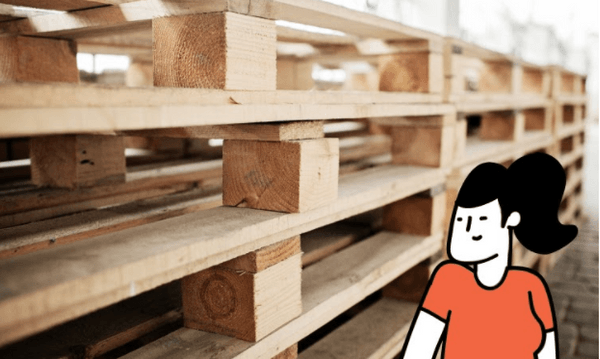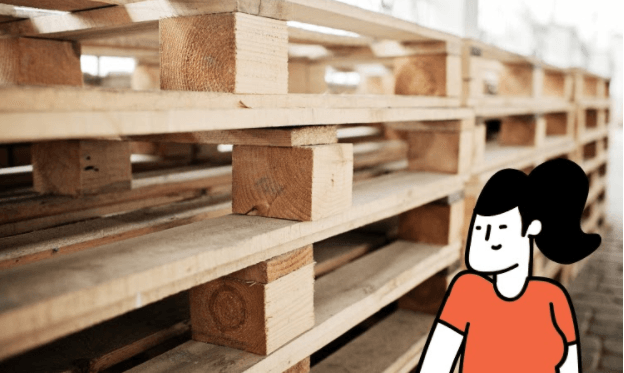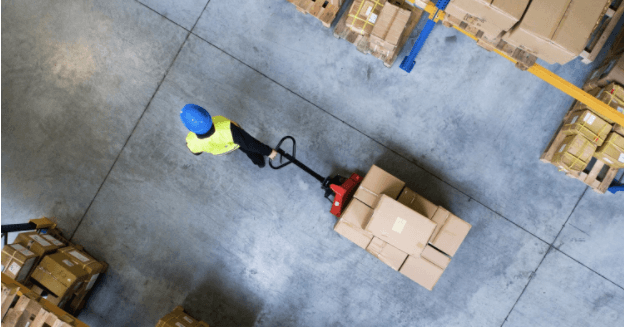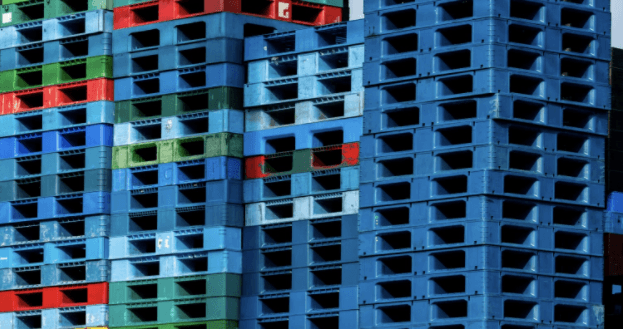Types Of Pallets Used In International Shipping

Pallets are the workhorses of the shipping industry, carrying heavy loads and subject to frequent movement. They make it easy to load goods into shipping containers using pallet jacks or forklift trucks.
Pallets are a common sight in the warehouses of the world, facilitating the storage and stacking of goods. The only pallet that isn’t chipped, scuffed, or stained is likely to be brand new.
To the untrained eye, one pallet might look much like another. But experts will spot key differences in seconds. While this article won’t turn you into an expert overnight, it contains a lot of useful information about the different types of pallets that you’ll come across as a shipper.

Why Pallets Are Useful In Shipping
The flat, horizontal nature of pallets make them ideal for stacking goods on top, which can then be easily moved and loaded into shipping containers. A standard 20ft shipping container has the capacity for 11 standard or Euro pallets. Larger 40ft containers can fit 21 standard pallets or 24 Euro pallets. We will look at the difference between standard and Euro pallets later.
What to Look Out For When Choosing Pallets
Here we take a closer look at the various features of pallets. The following information should be helpful when deciding on the right pallet for your international shipping.
Entry Points
Some pallets have entry points for the blades of forklift trucks on two sides (2-way pallet). Others have entry points on all four sides (4-way pallet). Closed pallets (or flat pallets) have just one side that forklifts can use for loading and are closed off by a slat along the side opposite to the opening.
Deck Types
Solid deck pallets have a flat surface made from a continuous sheet of plastic or metal, or a single cut of wood. This makes them easy to clean and ideal for shipping small objects, as there are no slats between which goods can fall.
The flat surface of some pallets is made from strips of wood, metal, or plastic with gaps in between each. These are known as open deck pallets. They’re lighter and less expensive than solid deck pallets, but aren’t suitable for shipping smaller items for the reason stated above.
Another type of pallet is the double face pallet with its distinctive ‘wings’ on the side. These are pallets with two levels, one above the other. The extra deck gives the pallet more strength to take heavier loads, enabling a more even distribution of weight across the pallet. Double face pallets are either reversible or non-reversible. The former has a load-bearing surface on both sides whereas the latter can only take loads on one side.
The Most Common Pallet Designs

There are two different types of pallets. Let’s take a look at each.
Block Pallets
Sometimes called deck-board pallets, the typical features you’ll find on these pallets include:
- 12 cylindrical posts
- Four-way entry
- Made from wood, plywood, or plastic
- Some have a bottom board
- Four to 12 blocks supporting the top deck board
- Easy to handle thanks to their parallel and perpendicular stringers
- Can be used together with stringer pallets
Stringer Pallets
Stringer pallets are popular in the USA. Stringers are the boards between the top and bottom deck board that support the load on the pallet. Three or more pieces of stringer are arranged in parallel. These pallets also have notches on the side to allow for partial four-way entry.
Stringer pallets are typically made from wood or plastic, and commonly have entry points for forks and pallet jacks on just two sides. That said, it is possible to find stringer pallets with four entry points.
Pallet Material: What Are Pallets Made From?
Pallets are made from various materials, each of which has advantages and disadvantages:
Wooden Pallets
Over 90% of all pallets in use are made from hardwood such as oak or softwood such as pine. Wooden pallets are often used to store and transport light, non-biodegradable materials.
All wooden pallets are subject to international ISPM 15 regulations. These stipulate that pallets must be made using debarked wood and treated with solutions designed to prevent pests from infecting the wood. Pallets complying with this directive should carry an identification plate to that effect.
Advantages
- Simple to repair.
- Strong grip thanks to a higher friction level than metal or plastic.
- Easy to recycle and customize for other uses in the home and garden.
Disadvantages
- As a natural material, wood is susceptible to contamination from bugs, chemicals, and bacteria.
- Must be kept dry as damp and wet conditions will damage them.
- As with all pallets, there’s a finite amount of weight wooden pallets can take before they splinter and snap. A safe maximum load for wooden pallets during transportation is 1500 kg.
Presswood pallets
These offer a natural alternative to plastic pallets and are made from processed wood fibers or recycled wood shavings and wooden waste. These materials are compacted together to form a single, solid wooden block.
Presswood pallets can be easily nested together so when not in use take up less than half the space of conventional pallets. They are also very lightweight and molded with rounded corners.
Reinforced ribs give these pallets the capacity to carry heavy loads. The disadvantages of presswood pallets are that they aren’t as strong as conventional wooden pallets and are susceptible to damage when damp or wet.
Plywood Pallets
These are incredibly light and able to survive much handling and loading. They offer more resistance to bugs and moisture than traditional wooden pallets and won’t warp, swell, or shrink. They come in single or double deck formats and require little care and maintenance.
Plastic Pallets

Plastic is getting a bad press in many walks of life. However, in the world of pallets, plastic is second only to wood in popularity. Plastic pallets are usually made from high-density polyethylene or recycled plastic bottles. They are frequently used to transport fresh and frozen food and pharmaceuticals.
Advantages
- Light
- Weather resistant – won’t corrode if they get wet
- Fire resistant
- 100% recyclable
- Resistant to chemicals and rot
- Easy to clean and sterilize
- Odor resistant
- Long lifespan (if not overloaded)
- Durable – the inevitable knocks, bangs, and scrapes during transportation have little effect on plastic pallets
Disadvantages
- Expensive
- Can break under the weight of heavy loads
- Difficult to repair when damaged.
Metal Pallets
Steel and aluminium are the metals most commonly used in pallet construction. Although metal pallets are strong and ideal for long-term usage, they are not as popular as wooden pallets due to their cost.
Metal pallets are generally used to store and transport metals, automobile parts, and military ammunition. Aluminum pallets are often used for transporting air freight due to their light weight. Steel pallets are popular with companies looking to store and transport food, tires, and batteries.
Advantages
- Stronger than wooden pallets
- Can be recycled
- Fireproof
- Sanitary
- Not subject to damage from bugs (unlike wooden pallets)
- Can withstand the effects of corrosion and the impact of various weather conditions
Disadvantages
- Can rust
- Not easy to repair
- Some metal pallets are heavy which impacts shipping costs
- More expensive than wooden pallets due to the material used
Eco Pallets
These environmentally-friendly types of pallets are ultra-light and easy to dispose of after use, so they don’t need to be returned to the supplier. This helps reduce shipping costs. Eco pallets are made from paper, corrugated cardboard, honeycomb cardboard, or fiberboard.
Advantages
- Lighter than wood or metal pallets
- Easy to clean
- Fully recyclable
- No need to return after using
Disadvantages
- Can’t hold heavy loads
- Cannot withstand wet or damp conditions
- Not durable
Which Type Of Pallet Should You Use?

You should consider the following criteria before choosing the type of pallet you need:
How will your goods be transported—by sea, air, land, or a combination of these? It’s worth remembering that wooden pallets are more susceptible to damage in damp conditions, so you may wish to choose another type of pallet if exposure to moisture is expected.
Where are your goods being shipped to? If you’re making an international shipment, your pallets will need to comply with ISPM regulations.
What’s your budget? Every cent you spend on your shipping can make a difference to your margins. So check to see which type of pallet offers you the most cost-effective option.
How big is your consignment? Answering this will help you choose the size and number of pallets your consignment needs.
How heavy are your items? Every pallet type has a maximum load it can bear before damage is likely. For example, a safe load for a standard wooden pallet during shipping is 1500kg.
How often are you likely to use your pallets? If it’s just for one shipment, paper pallets or second-hand pallets could work best.
Size Matters
There are five pallet sizes which are recognised by the ISO and used in different parts of the world:
800mm x 1200mm Europe 1000mm x 1200mm Europe, Asia 1100mm x 1100mm Asia 1165mm x 1165mm Australia, North America, Europe, Asia 1219mm x 1016mm North America
Other pallets with different dimensions are in use, but the above represent the sizes in most common usage. It’s wise not to use pallets in the above territories that do not comply with the dimensions stated.
What Are Euro-Pallets?
Around 500 million Euro pallets are currently in circulation. These pallets are manufactured according to strict quality regulations and are occasionally inspected by independent firms.
All official European pallets will feature the EUR logo or the abbreviations DB or EPAL. The wooden planks will be two centimeters thick. Beware of cheap imitations with fake logos and wooden planks that are only one centimeter thick.
Euro pallet Dimensions:
- Length: 1200mm
- Weight: 800mm
- Height: 144mm
- Weight: 25kg
- Transport Maximum Load Weight: 1500kg
- Storage Maximum Load Weight: 5500kg
Euro pallets are usually made from wood and should carry the ISPM NO-5 standards markings.
How To Safely Load Pallets
Will you be sending a shipment of goods on pallets as a full container load, rather than using a less-than-container-load (LCL) service? If so, you (or your supplier if you are the consignee) will have the responsibility for stuffing the shipping container.
***The pallets must be loaded safely into the container, in a way that prevents them from moving and enables safe and efficient unloading at the final delivery destination. ***
The following tips will help you to make sure your pallets are loaded correctly:
- Be sure you know the weight and height of your load before stuffing the container
- Know how many pallets your chosen container can accommodate
- The load should not overhang the edges of the pallet
- Store your pallets in a location that can be easily accessed by a forklift truck or pallet jack
- Ensure there are no gaps between pallets
- Load pallets crossways where possible
Pallets: The Load Platform for Easier Shipping
Although some items can be safely shipped without them, pallets are an essential element of many international shipments. They make it easy to store and move goods during the shipping process.
***As this article has shown, there are many different types of pallets in use around the world. It’s important to use the right size of pallet for your consignment to ensure it meets shipping regulations. ***
If in doubt, you can always ask your freight forwarder to help you identify the best pallets for your shipment, taking into account the countries of origin and destination.


